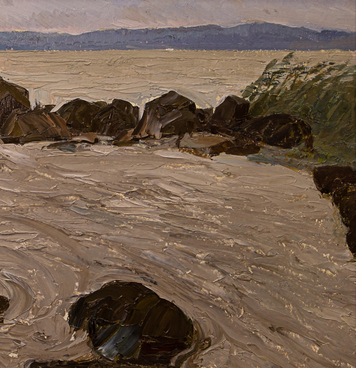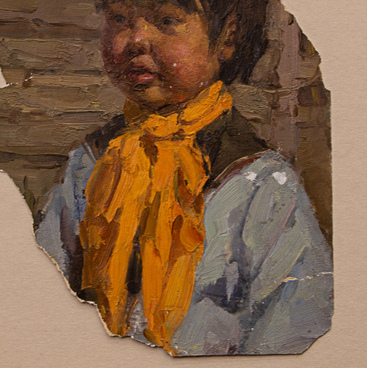The name of Sophia Semyonovna Vitukhnovskaya, born in the town of Pavlovo near the Oka River, holds a prominent place in the cultural life of Komsomolsk-on-Amur residents.
Sophia Vitukhnovskaya’s student years coincided with a turning point in Russian art when the culture of the nobility, merchants and patrons of the arts was superseded by that of the proletariat. Between 1929 and 1937, she was mentored by such outstanding artists as Vyacheslav Nikolayevich Rutsay, Sergey Vasilyevich Gerasimov, Boris Vladimirovich Ioganson and others. During her studies, she met Hoskel Sandler — her future husband. Sophia Vitukhnovskaya learned a lot about the construction of Komsomolsk-on-Amur from him and her brother Mikhail, who wrote the script for the movie called “Komsomolsk”.
In 1937, the city of Komsomolsk was preparing for its fifth anniversary; among other things, an art exhibition was planned to commemorate the occasion. There, the participants were going to present their studies of future canvases, dedicated to the city. Sandler and Vitukhnovskaya also came to Komsomolsk. They worked a lot both in the studio and en plein air, held classes in an art studio, and organized exhibitions for their students. Sophia Vitukhnovskaya painted oil landscapes and portraits and created stage sets.
When the couple returned to Moscow in 1939, their joint exhibition, consisting of 46 paintings dedicated to Amur, was held at the Moscow Union of Artists.
Next time, Sophia Vitukhnovskaya and Hoskel Sandler visited Komsomolsk-on-Amur when they received an invitation in 1964, and an idea struck the artists to open an art gallery in the city. Their appeal “Give artworks to Komsomolsk residents!” was published in the newspapers “Sovetskaya Kultura” (Soviet Culture) and “Moskovskiy Rabochiy” (Moscow Worker); the Art Fund of the USSR agreed to supervise which paintings constituted the future collection.
The first parcel with carefully selected paintings and graphic works, including those by Sophia Vitukhnovskaya and Hoskel Sandler, was sent as a gift to Komsomolsk residents in 1965. A year later, the gallery was opened in the city, and the founding artists supervised it for the rest of their lives.
An amateur theater club at first, the Nanai Theater was founded in 1932, and by 1937 had already been recognized by the Regional Executive Committee and was successfully staging revolutionary plays based on Nanai folklore. The displayed portrait presumably depicts Isar Situlovich Passar — a self-taught violinist and actor of the Nanai Theater in the village of Naikhin. The portrait was most likely painted in 1937 when the troupe was on tour in Komsomolsk.
Sophia Vitukhnovskaya’s student years coincided with a turning point in Russian art when the culture of the nobility, merchants and patrons of the arts was superseded by that of the proletariat. Between 1929 and 1937, she was mentored by such outstanding artists as Vyacheslav Nikolayevich Rutsay, Sergey Vasilyevich Gerasimov, Boris Vladimirovich Ioganson and others. During her studies, she met Hoskel Sandler — her future husband. Sophia Vitukhnovskaya learned a lot about the construction of Komsomolsk-on-Amur from him and her brother Mikhail, who wrote the script for the movie called “Komsomolsk”.
In 1937, the city of Komsomolsk was preparing for its fifth anniversary; among other things, an art exhibition was planned to commemorate the occasion. There, the participants were going to present their studies of future canvases, dedicated to the city. Sandler and Vitukhnovskaya also came to Komsomolsk. They worked a lot both in the studio and en plein air, held classes in an art studio, and organized exhibitions for their students. Sophia Vitukhnovskaya painted oil landscapes and portraits and created stage sets.
When the couple returned to Moscow in 1939, their joint exhibition, consisting of 46 paintings dedicated to Amur, was held at the Moscow Union of Artists.
Next time, Sophia Vitukhnovskaya and Hoskel Sandler visited Komsomolsk-on-Amur when they received an invitation in 1964, and an idea struck the artists to open an art gallery in the city. Their appeal “Give artworks to Komsomolsk residents!” was published in the newspapers “Sovetskaya Kultura” (Soviet Culture) and “Moskovskiy Rabochiy” (Moscow Worker); the Art Fund of the USSR agreed to supervise which paintings constituted the future collection.
The first parcel with carefully selected paintings and graphic works, including those by Sophia Vitukhnovskaya and Hoskel Sandler, was sent as a gift to Komsomolsk residents in 1965. A year later, the gallery was opened in the city, and the founding artists supervised it for the rest of their lives.
An amateur theater club at first, the Nanai Theater was founded in 1932, and by 1937 had already been recognized by the Regional Executive Committee and was successfully staging revolutionary plays based on Nanai folklore. The displayed portrait presumably depicts Isar Situlovich Passar — a self-taught violinist and actor of the Nanai Theater in the village of Naikhin. The portrait was most likely painted in 1937 when the troupe was on tour in Komsomolsk.


